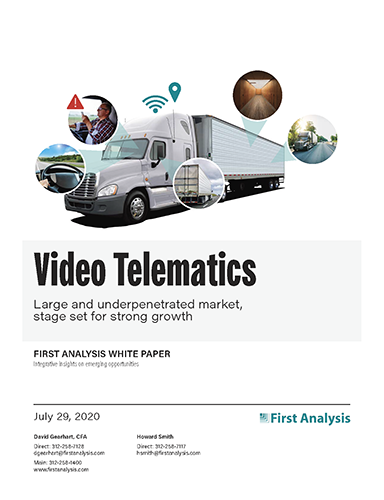White paper: Video telematics
Large and underpenetrated market, stage set for strong growth

Video telematics, which uses camera technologies combined with traditional telematics capabilities and increasingly advanced driver-assistance systems (ADAS), is experiencing a surge in adoption as fleet operators and managers have become more interested in the situational intelligence afforded by captured footage that can be used to exonerate drivers post-incident and in training them to reduce undesired behaviors.
While in-vehicle camera systems have existed for over 20 years, they are finally poised to see much stronger connection growth due a confluence of factors, such as being preceded by broadly accepted traditional telematics monitoring solutions, significant declines in enabling hardware and data costs, improvements in technology, incorporation of automated capabilities, and a growing focus on safety and performance following a rise in accident rates, high-cost legal judgments, and commercial vehicle insurance costs.
We estimate the U.S. and Canadian markets generated $950 million in revenue from wireless-enabled video telematics solutions in 2019, aggregating hardware and recurring service components, with a penetration rate below 3%. We expect the market to grow approximately 22% annually to reach $6.8 billion by 2029, representing 31% penetration.
The market currently features over 50 video solutions providers, which compares to the several hundred in traditional telematics. We expect the number of video providers to rise significantly and for most of these to be successful in the near term due to the high return on investment (ROI) from deploying an average solution and due to the low market penetration of video, although we anticipate those players that are vertically focused, offer easy to install and use solutions, have some scale, and emphasize video analytics and machine learning to disproportionately benefit over time.
TABLE OF CONTENTS
Includes profiles of DGLY, MIXT, TRAK.L, TRMB, VRRM and 36 private companies
- What is video telematics?
- Solution overview – components of a modern offering
- Features, capabilities
- Incorporating advanced driver-assistance systems
- Automated video capture triggers
- Vertical markets
- Why video telematics is needed
- Benefits
- Return on investment example
- Business models
- Pricing
- Sizing the video telematics market opportunity
- Adoption drivers: Why the market is poised for strong growth
- Segmenting the market
- Competition
- Success drivers
- Trends, observations, other thoughts
- Public and private video telematics company profiles
Introduction
This report presents a high-level overview of the video telematics market, beginning with a description of basic solutions and their components. We then look at industry history, use cases, potential benefits, market size, growth expectations, and factors driving adoption. In addition, we segment the market on a variety of dimensions and outline the attributes we expect successful companies in the space to exhibit in the near and long term. After this overview, we profile some of the public and private players to provide additional market context.
What is video telematics?
Video telematics represents a category of mobile-asset camera solutions designed to give fleet operators visibility into driver actions, such as cell phone use and texting, and events involving their vehicles, such as near-misses and crashes, through captured footage. In contrast to traditional telematics solutions, which collect and report numerical sensor data generated by a connected vehicle, such as location, heading, speed, braking, and impact, video is more holistic, as it is able to go beyond the vehicle to gather information on the environment itself, including other vehicles and assets in the vicinity as well as road and weather conditions. This information provides fleet operators with the crucial element of context, or what we deem “situational intelligence,” with the recorded footage enabling them to understand and diagnose why a driver action or vehicle event occurred, not simply that it occurred (as reported by a traditional telematics solution).
We note these solutions can record forward (road) and rear (driver) facing activity, among many other potential camera views, either continuously upon vehicle activation or in smaller, curated segments when initiated autonomously by a triggering event. The footage, accessible through a wireless network with a smartphone, tablet, or computer-based application, has many uses, such as post-incident forensics (to assign fault, exonerate a driver), safety improvement (by fostering desired driver behaviors with video review and coaching), and adherence (compliance with seat belt laws, hands free rules), all of which, among other factors, are driving video solutions adoption.

Request full report
To access the full report, please provide your contact information in the form below. Thank you for your interest in First Analysis research.
